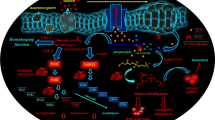Abstract:
The prostaglandin series of bioactive compounds is formed by the interaction of two distinct but related enzymes, cyclo-oxygenase-1 (COX-1) and cyclo-oxygenase-2 (COX-2). COX-1 is a constitutive form which is present mainly in the gastric mucosa, kidney and platelets. COX-2 is mainly an inducible form, although also to some extent present constitutively in the CNS, the juxtaglomerular apparatus of the kidney and in the placenta during late gestation. Both isoforms contribute to the inflammatory process, but COX-2 is of considerable therapeutic interest as it is induced, resulting in an enhanced formation of prostaglandins, during acute as well as chronic inflammation. Conventional NSAIDs inhibit both isoforms to a similar extent and in an approximately equal dose and concentration range. The two recently developed and clinically available selective COX-2 inhibitors, celecoxib and rofecoxib, are about 100–1000 times more selective on the COX-2 than on the COX-1 isoform. In Europe rofecoxib is today indicated for the symptoms and signs of osteoarthritis, whereas celecoxib is indicated for both osteoarthritis and rheumatoid arthritis. The major clinical interest of these drugs has been related to the lower incidence of gastrointestinal bleeding which, with the conventional COX-1/COX-2 agents has been a source of hospitalisation, disablement and death, especially in the elderly. Clinical trials have convincingly demonstrated that celecoxib and rofecoxib in clinical use induce very few gastrointestinal complications compared to conventional and non-selective NSAIDs. However, the well known contraindications for NSAIDs, such as late pregnancy, aspirin-induced asthma, congestive heart failure and renal dysfunction, will so far apply also to the COX-2 inhibitors. Compared to the traditional and non-selective NSAIDs, COX-2 inhibitors may provide an insight into additional therapeutic areas, such as gastrointestinal cancer and dementia, where the potential relevance to COX-2 mechanisms are currently being explored and clinical trials being performed. With the rapid clinical acceptance of celecoxib and rofecoxib, knowledge about their clinical usefulness in various inflammatory disease states and pain disorders is increasing. For the many patients suffering from such conditions, the selective COX-2 inhibitors are likely to become a significant addition to the therapeutic arsenal of analgesic and anti-inflammatory drugs.
Similar content being viewed by others
Author information
Authors and Affiliations
Additional information
Received: 15 December 1999 / Accepted: 4 April 2000
Rights and permissions
About this article
Cite this article
Everts, B., Währborg, P. & Hedner, T. COX-2-Specific Inhibitors – the Emergence of a New Class of Analgesic and Anti-inflammatory Drugs. Clin Rheumatol 19, 331–343 (2000). https://doi.org/10.1007/s100670070024
Issue Date:
DOI: https://doi.org/10.1007/s100670070024




